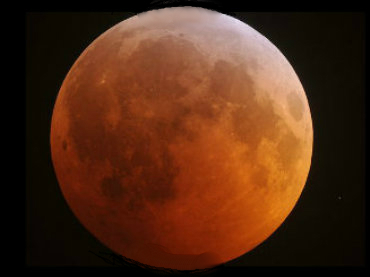- Sections :
- Crime & Public Safety
- Restaurants & Food
- Sports
- More
Categories
Supermoon coincides with lunar eclipse Sept 27

Prepare to be moonstruck this Sunday evening, September 27, when a 'Supermoon' will coincide with a lunar eclipse; an event that hasn’t occurred in 32 years, and won’t happen again until 2029.
The Supermoon occurs when the moon is closest to the Earth, so it appears larger than usual. The point of least distance between the Earth and the moon is referred to as the perigee; the greatest distance between the two is the apogee.
'There’s no physical difference in the moon,' said NASA scientist, Noah Petro, in a statement. 'Because the orbit of the moon is not a perfect circle, the moon is sometimes closer to the Earth than at other times during its orbit,' he added.
The moon will appear approximately 14% larger than normal, according to NASA. What will make the event unique is that this larger than normal orb will disappear when the Earth moves between the moon and the sun, casting its shadow on the lunar surface.
The moon will take on a reddish cast during this Supermoon event.
'That red light shining onto the moon is sunlight that has skimmed and bent through Earth's atmosphere: that is, from all the sunrises and sunsets that ring the world at any given moment,' according to Alan MacRobert of Sky and Telescope magazine.
The red color is the reason for the nickname a 'blood' moon.
The total eclipse will begin at 9:11 p.m. Central Daylight Time Sunday evening and will last one hour and twelve minutes, and will be visible across North America, with the eastern half of North America capable of watching every stage of the eclipse, from beginning to end, weather permitting. The rest of the world able to view this phenomenon include South America, Europe, Africa, parts of West Asia and the eastern Pacific.
No special glasses or lenses are required like when viewing a solar eclipse; you’ll be able to stare directly at the moon, but binoculars or a telescope will improve the view. Don’t miss this spectacular celestial event! According to NASA, there have been just five such events in the last 115 years. Since 1900, the Supermoon in tandem with a lunar eclipse has occurred in 1910, 1928, 1946, 1964, and 1982. This will be the last total lunar eclipse visible anywhere on Earth until 2018, and the next total solar eclipse won’t occur until August 2017. If you miss the Supermoon lunar eclipse combo, you’ll have to wait another 15 years. The year 2029 seems like a long time away.
#Moonstruck
The Supermoon occurs when the moon is closest to the Earth, so it appears larger than usual. The point of least distance between the Earth and the moon is referred to as the perigee; the greatest distance between the two is the apogee.
'There’s no physical difference in the moon,' said NASA scientist, Noah Petro, in a statement. 'Because the orbit of the moon is not a perfect circle, the moon is sometimes closer to the Earth than at other times during its orbit,' he added.
The moon will appear approximately 14% larger than normal, according to NASA. What will make the event unique is that this larger than normal orb will disappear when the Earth moves between the moon and the sun, casting its shadow on the lunar surface.
The moon will take on a reddish cast during this Supermoon event.
'That red light shining onto the moon is sunlight that has skimmed and bent through Earth's atmosphere: that is, from all the sunrises and sunsets that ring the world at any given moment,' according to Alan MacRobert of Sky and Telescope magazine.
The red color is the reason for the nickname a 'blood' moon.
The total eclipse will begin at 9:11 p.m. Central Daylight Time Sunday evening and will last one hour and twelve minutes, and will be visible across North America, with the eastern half of North America capable of watching every stage of the eclipse, from beginning to end, weather permitting. The rest of the world able to view this phenomenon include South America, Europe, Africa, parts of West Asia and the eastern Pacific.
No special glasses or lenses are required like when viewing a solar eclipse; you’ll be able to stare directly at the moon, but binoculars or a telescope will improve the view. Don’t miss this spectacular celestial event! According to NASA, there have been just five such events in the last 115 years. Since 1900, the Supermoon in tandem with a lunar eclipse has occurred in 1910, 1928, 1946, 1964, and 1982. This will be the last total lunar eclipse visible anywhere on Earth until 2018, and the next total solar eclipse won’t occur until August 2017. If you miss the Supermoon lunar eclipse combo, you’ll have to wait another 15 years. The year 2029 seems like a long time away.
#Moonstruck
Comments •

















